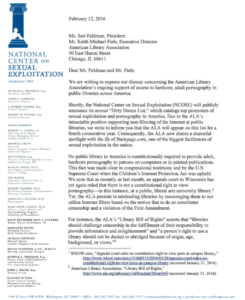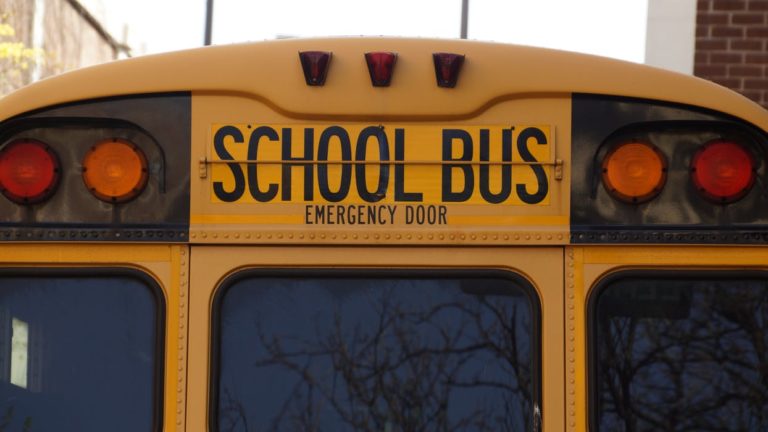Download a PDF Copy of our Letter Here.
Dear Ms. Feldman and Mr. Fiels:
We are writing to express our dismay concerning the American Library Association’s ongoing support of access to hardcore, adult pornography in public libraries across America.
Shortly, the National Center on Sexual Exploitation (NCOSE) will publicly announce its annual “Dirty Dozen List,” which catalogs top promoters of sexual exploitation and pornography in America. Due to the ALA’s intractable position supporting non-filtering of the Internet at public libraries, we write to inform you that the ALA will appear on this list for a fourth consecutive year. Consequently, the ALA now shares a shameful spotlight with the ilk of Backpage.com, one of the biggest facilitators of sexual exploitation in the nation.
No public library in America is constitutionally required to provide adult, hardcore pornography to patrons on computers or in printed publications. This fact was made clear in congressional testimony and by the U.S. Supreme Court when the Children’s Internet Protection Act was upheld. We note that as recently as last month, an appeals court in Wisconsin has yet again ruled that there is not a constitutional right to view pornography—in this instance, at a public, liberal arts university library.1 Yet, the ALA persists in misleading libraries by encouraging them to not utilize Internet filters based on the notion that to do so constitutes censorship and a violation of the First Amendment.
For instance, the ALA’s “Library Bill of Rights” asserts that “libraries should challenge censorship in the fulfillment of their responsibility to provide information and enlightenment” and “a person’s right to use a library should not be denied or abridged because of origin, age, background, or views.”2
Surely, it is time for a more nuanced articulation of library rights, since with respect to adult, hardcore pornography:
- it is not a form of protected speech under the First Amendment;
- a right to view material that is not protected speech cannot be denied or abridged because such a right does not exist;
- a blanket charge to libraries to “challenge censorship” in this context is encouraging them to flout federal law; and
- children should be especially guarded from harmful and dangerous material such as hardcore, adult pornography, but no one, no matter their age, origin, background or views, has a protected right to view hardcore, adult pornography at a public library.

The ALA’s opposition to Internet filters that block pornography at public libraries is extreme in its willingness to assent to access to illegal, obscene material, no matter the cost to the public the ALA purports to serve. In an age when our society is struggling to cope with serious child and adult sexual exploitation,[3] racially-motivated sexual violence,[4] an epidemic of sexual assault on college and university campuses,[5] rife human trafficking of persons for purposes of commercial sexual exploitation,[6] child sexual abuse that is 167 times more common than autism in children,[7] and childhood sexual abuse that in 81.2% of cases is being perpetrated by parents,[8] adult, hardcore pornography only serves to exacerbate deeply entrenched social ills that have devastating impacts at the individual and societal level. Thus, it is long past time for the ALA to take measures to ensure that public libraries are community spaces free from sexually toxic material.
A wealth of peer-reviewed research demonstrates the many harms of pornography. For instance, a growing body of neuroscience reveals that adults are developing addictions to pornography, as pornography hijacks the brain’s reward center in a way similar to drug addiction.[9] Moreover, an alarming, nationally representative online survey of 3,000 people reveals that nearly half of young people (ages 13-24) actively seek out pornography weekly or more often.[10] This is especially troubling given that research shows that adolescents are more susceptible to forming addictions than adults, because the dopamine neurons in their nucleus accumbens (i.e. the brain’s pleasure center) are much more active and have an exaggerated plasticity in response to addictive stimulus.[11] Thus, it can be said that a propensity for addiction is more strongly “hardwired” into the adolescent brain.[12]
This should be particularly concerning to the ALA, as studies have found that adolescents commonly stumble upon sexually explicit material while searching for information—a common activity of children and teens doing school work on library computers. For instance, one study found that 42% of adolescents reported exposure to pornography within the past year, with 66% of those teens describing such exposure as unwanted.[13] This is alarming given that Internet pornography consumption by adolescents is associated with risky sexual behavior that can have profoundly adverse effects such as anal sex, multiple sexual partners, and substance use during sex.[14] However, such outcomes are not surprising in light of research into how the human brain develops which shows that adolescents are not as readily able to access their frontal lobes—the portion of the brain that controls impulses and allows for rapid, smart decision making.[15]
Furthermore, sexual violence against women, including sexual harassment and rape, are correlated to the consumption of pornography. A recent meta-analysis of 22 studies from seven countries provides clear evidence confirming that pornography exposure is associated with sexual aggression in the United States and internationally, among both males and females; associations are stronger for verbal than physical sexual aggression, but both are significant.[14] As the authors state, “the accumulated data leave little doubt that, on the average, individuals who consume pornography more frequently are more likely to hold attitudes conducive to sexual aggression and engage in actual acts of sexual aggression than individuals who do not consume pornography or who consume pornography less frequently.”[15]
A separate meta-analysis of 46 studies demonstrated that pornography contributes to the development of sexually dysfunctional attitudes and behaviors including:
1) developing sexual deviant tendencies;
2) committing sexual offenses;
3) experiencing difficulties in intimate relationships; and
4) accepting rape myths.[16]
Further, older adolescents who use pornography are more likely to be attracted to 13 or 14 year olds,[17] and the earlier college men were exposed to pornography the more likely they are to have engaged in nonconsensual sex.[18] Fraternity men who consume mainstream pornography express a greater intent to commit rape; those who consume sadomasochistic pornography express significantly less willingness to intervene in situations of sexual violence, greater beliefs in rape myths, and greater intent to commit rape; and, among those who consume rape-themed pornography, the researchers described “serious effects” including less bystander willingness to intervene, greater belief in rape myth, and greater intent to commit rape.[19] In other words, there was no type of pornography that did not result in a greater intent to commit rape. From this small sampling of a rich body of research, it is clear that hardcore, adult pornography is not benign “information” that promotes the “enlightenment” of people.
In addition, sexual harassment and sexual assault of library staff and patrons is not an uncommon occurrence, with recent cases being reported in California[20] and Florida.[21] In another instance occurring in Wisconsin, a man was charged with 1st degree sexual assault for touching an 8-year-old girl at the library—the man was known to police in Oregon for searching for pornography at a high school, fire department office, and library.[22] And, just last month police arrested a convicted child molester for collecting images of child sexual exploitation (i.e. child pornography) at the University of Washington, a mental health clinic, and Seattle Public Library.[23] The images showed the sexual abuse of several young children.[24]
These factors make it gravely irresponsible to provide unfiltered Internet at public libraries. Facilitating potential access to illegal, obscene material—much of which is degrading and violent— may excite sexual fantasies among library patrons who consume such material on library premises, prompting some to act out. Such concerns notwithstanding, a public library in Billings, Montana, provides “privacy shields” on four unfiltered computers, thereby facilitating possible pornography consumption among its patrons.[25] Despite the shield, a teacher on a school trip to the Billings library witnessed a man viewing pornography on one of its computers.[26] Such activity in a public setting creates a sexually hostile environment for other library patrons. Do they not have a right to utilize the resources of the public library in a safe and non-threatening setting?
Despite the aforementioned research findings and incidents involving access to hardcore, adult pornography and child sexual abuse images at public libraries, the ALA has failed to acknowledge the real and serious harms of illegal, obscene materials. For instance, its 2014 report Fencing out Knowledge: Impacts of the Children’s Internet Protection Act 10 Years Later, the ALA gives little, if any, credence to the harms of illegal, obscene materials, and instead, presents overwrought claims about the impact of Internet filtering on libraries and public schools.
In Fencing out Knowledge, the ALA claims that Internet filters are subject to “technical limitations [which] continue to preclude the accurate identification of obscene images on the internet. . . .”[27] The report also suggests that Internet filters are exclusively based on keywords or flesh tones and are not keeping up with technology, yet simultaneously admits that “few studies measuring the performance of internet filters have been conducted since 2008.”[28]
It is 2016 and Internet filters have come a long way. Ronald DeHaas, President of Covenant Eyes, Inc., an Internet accountability and filtering company, confirms that when today’s filters are used to identify and block pornography, they are highly effective. Nevertheless, the ALA claims that filters are only accurate 83% of the time, and complains of “substantial blocking of legitimate content”[29] known as “overblocking.” In the Internet filtering industry, instances of overblocking are referred to as “false positives.” DeHaas reports that false positives have become so extremely rare, as to be inconsequential. His company’s Internet filtering system is more than 99.9% successful in avoiding overblocking sites rated as pornography in that system. Moreover, within the Internet filtering industry, false negatives (e.g. underblocking) are more common than false positives, meaning that any error in the technology is more likely to result in a person accessing pornography than not being able to access legitimate content.
Furthermore, state-of-the-art image recognition technology, for both still images and videos, is being developed by Covenant Eyes and will be released later this year. This technology does not use skin tones to recognize pornography, as discussed in Fencing out Knowledge, but rather uses convolutional neural networks that “learn” to recognize pornography through artificial intelligence. Similarity to pornography is determined on a scale of 0 to 100—zero being pornography, 100 being totally “clean.” When the threshold is set below 20, accuracy for false positives exceeds 99.5%. A library could choose a threshold that would give accuracy more than 99.9%, and effectively filter against true, hardcore pornography while not blocking legitimate content. Even though this technology is still under development, today’s filtering technology is already much more highly accurate than suggested by the outdated studies cited in the Fencing out Knowledge policy brief.
Additionally, readers of Fencing out Knowledge come away from the document with the impression that the ALA views the Internet as a harmless environment, where both children and adults can mingle and exchange information and ideas with little threat of serious harm. With respect to use of the Internet at schools it suggests that “riding in a school bus or participating in organized sports present risks that should be considered, yet few would deem the risks of these activities to outweigh their benefits.”[30] Riding the school bus and participating in organized sports, are activities conducted within the protective oversight of school administrators, teachers, and the local community. Moreover critical safety measures are erected to minimize potential risks to students. Unfettered Internet access, however, opens schools and libraries to an overwhelming torrent of toxic pornography, that no school can possibly manage to shield students from without the aid of Internet filters. The ALA should recognize that filters are to the Internet, what crossing arms are to school buses. Internet filters guard students from the onslaught of illegal, obscene material widely available on the Internet.
The report further opines that, “Swimming pools can be dangerous for children. To protect them, one can install locks, put up fences, and deploy pool alarms. All of these measures are helpful, but by far the most important thing that one can do for one’s children is teach them to swim.”[31] We agree. Teaching children to swim is vital to preventing drowning, just as teaching children skills to navigate the Internet is an important step in preserving their online safety. However, the skill of swimming is of little good if children are dropped, not in a pool, but a shark tank. The Internet, for all its good, bears more resemblance to a shark tank than it ever did a swimming pool. Filtering out the sharks of illegal obscenity hardly seems unreasonable.
In summary, one is hard pressed to argue that protecting adult, hardcore pornography—with its raw, brutal, debasing, violent, and hate-filled themes—was what the framers envisioned when they crafted the First Amendment to the Constitution. Indeed, the Courts have found that his was not so. While the First Amendment’s protection of free speech is indeed our first liberty, it is by no means a license to provide unfettered access to illegal, obscene materials in public settings. Thus, we exhort the ALA to become a responsible actor on this issue by acknowledging the harm of illegal, obscene materials, and to work towards meaningful solutions to block its access in the public sphere of the community library and schools.
All girls, boys, women, and men have a natural human dignity and thus a right to live lives free from sexual exploitation. All pornography is degrading, dehumanizing, exploitive, and a violation of this right. All pornography is a serial attack on human dignity, identity and worth. As obscenity, hardcore, adult pornography has no place in the public square, much less the public library.
Our nation is now suffering from an emerging public health crisis fueled by the widespread distribution of adult, hardcore pornography, and the American Library Association bears a great burden of responsibility for this crisis. Accordingly, we request to meet with you and your representatives to discuss the matter of initiating new policy guidelines prohibiting access to adult, hardcore pornography at all public libraries.
cc:
- Dr. Julie B. Todaro, President-elect
- John DeSantis, Executive Board Member
- Loida A. Garcia-Febo, Executive Board Member
- Peter Hepburn, Executive Board Member
- Julius C. Jefferson, Jr., Executive Board Member
- Sarah Kelly Johns, Executive Board Member
- Mike L. Martin, Executive Board Member
- James Neal, Executive Board Member
- Gina Persichini, Executive Board Member
- Representative Tom Cole, Chairman, Subcommittee of Labor, Health and Human Services, Education and Related Agencies, Committee on Appropriation
- Representative Hal Rogers, Chairman, Committee on Appropriations
- Senator Roy Blunt, Chairman, Subcommittee on the Departments of Labor, Health and Human Services, Education, and Related Agencies
- Senator Thad Cochran, Chairman, Committee on Appropriations
1 WKOW.com, “Appeals court rules no constitution right to view porn at campus library,” http://www.wkow.com/story/31060535/2016/01/26/appeals-court-rules-no-constitutional-right-to-view-born-at-campus-library (accessed January 31, 2016).
2 American Library Association, “Library Bill of Rights,” http://www.ala.org/advocacy/intfreedom/librarybill (accessed January 31, 2016).
[3] Bryce Covert, “Women in Baltimore Public Housing Were Forced to Trade Sex for Basic Repairs.” Think Progress (Jan 9, 2016), http://thinkprogress.org/economy/2016/01/09/3737612/baltimore-housing-sex-settlement/ (accessed January 9, 2016); U.S. Department of Justice. “The National Strategy for Child Exploitation Prevention and Interdiction: A Report to Congress, (August 2010), http://www.justice.gov/psc/docs/natstrategyreport.pdf (accessed January 14, 2016).
[4] Victoria Olive, “Sexual Assault against Women of Color.” Journal of Student Research 1 (2012): 1-19; Gabby Bess, “Notre Dame Tutor Accused of Forcing Student into ‘Racially Motivated’ Sex.” Broadly, (November 2, 2015), https://broadly.vice.com/en_us/article/notre-dame-tutor-accused-of-forcing-student-into-racially-motivated-sex (accessed January 14, 2016); Donna M. Hughes, “’Welcome to Rape Camp’ Sexual Exploitation and the Internet in Cambodia.” Journal of Sexual Aggression 6, no. 1/2 (2000):1-23, http://www.uri.edu/artsci/wms/hughes/rapecamp.htm (accessed January 14, 2016).
[5] The White House Council on Women and Girls. Rape and Sexual Assault: A Renewed Call to Action, (2014), https://www.whitehouse.gov/sites/default/files/docs/sexual_assault_report_1-21-14.pdf (accessed January 9, 2016).
[6] Polaris. 2014 Statistics, https://polarisproject.org/sites/default/files/2014Statistics.pdf (accessed January 9, 2016).
[7] National Coalition to Prevent Child Sexual Abuse and Exploitation. The Health Impact on Children & Youth. http://www.preventtogether.org/Resources/Documents/Health_Impact_on_Youth.pdf (accessed January 9, 2016).
[8] U.S. Department of Health and Human Services, Administration for Children and Families, Administration on Children, Youth and Families. Children’s Bureau. Child Maltreatment, 2010. Data Source for CM 2010 Table 5-5 Perpetrators by Relationship to Victims 2010. http://www.acf.hhs.gov/programs/cb/resource/child-maltreatment-2010-data-tables (accessed January 9, 2016).
[9] Simone Kühn and Jürgen Gallinat, “Brain Structure and Functional Connectivity Associated with Pornography Consumption: The Brain on Porn,” JAMA Psychiatry 71, no. 7 (2014): 827-834. Ji-Woo Seok and Jin-Hun Sohn, “Neural Substrates of Sexual Desire in Individuals with Problematic Hypersexual Behavior,” Frontiers in Behavioral Neuroscience, (November 30, 2015). Porn Study Critiques, “Current List of Brain Studies on Porn Users, (September 29, 2015) http://pornstudycritiques.com/current-list-of-brain-studies-on-porn-users/ (accessed January 28, 2016).
[10] Barna Group, “The Porn Phenomenon: A Comprehensive New Survey on Americans, the Church, and Pornography,” (2016); Porn Study Critiques, Analyzing Selected Research & Reviews, “Current List of Brain Studies on Porn Users,” http://pornstudycritiques.com/current-list-of-brain-studies-on-porn-users/ (accessed January 30, 2016).
[11] Ibid.
[12] Ibid.
[13] Janis Wolak, Kimberly Mitchell, and David Finkelhor, “Unwanted and Wanted Exposure to Online Pornography in a National Sample of Youth Internet Users” Pediatrics 112, no. 2 (February 2007): 247-257.
[14] Debra Braun-Courville and Mary Rojas, “Exposure to Sexually Explicit Web Site and Adolescent Sexual Attitudes and Behaviors 45 (2009): 156-162.
[15] Frances E. Jensen with Amy Ellis Nutt, The Teenage Brain: A Neuroscientist’s Survival Guild to Raising Adolescents and Young Adults, (New York: Harper Collins, 2015).
[14] Paul J. Wright, Robert S. Tokunaga, and Ashley Kraus. “A Meta-Analysis of Pornography Consumption and Actual Acts of Sexual Aggression in General Population Studies.” Journal of Communication, (December 29, 2015): 1-23.
[15] Ibid.
[16] Elizabeth Paolucci-Oddone, Mark Genuis, and Claudio Violato, “A Meta-Analysis of the Published Research on the Effects of Pornography. In C. Violato, E. Paolucci-Oddone, & M. Genius (Eds). The Changing Family and Child Development (Aldershot, England: Ashgate Publishing), 2000: 48-59.
[17] Kristinn Henga, Svein Mossige, and Lars Wichstrom, “Older Adolescents’ Positive Attitudes toward Younger Adolescents as Sexual Partners,” Adolescence 39, no. 156, (2004): 627-651.
[18] Mary Anne Layden, unpublished data, 2015.
[19] John Foubert, Matt Brosi, and R. Bannon, “Pornography Viewing among Fraternity Men: Effects on Bystander Intervention, Rape Myth Acceptance & Behavioral Intent to Commit Sexual Assault, Sexual Addiction & Compulsivity, 18, no. 4 (2011): 212-231.
[20] KTVU, “SF Police Seek Suspect in Library Bathroom Sexual Assault on Juvenile” http://www.ktvu.com/news/28623375-story (accessed January 31, 2016).
[21] Chris Bonanno, “Man in Cocoa Library Accused of Sexual Abuse of Child,” Florida Today, http://www.floridatoday.com/story/news/crime/2016/01/29/jacksonville-man-accused-sexual-abuse-child/79480414/ (accessed January 31, 2016).
[22] Ed Treleven, “Man Charged with Touching 8-Year-Old Girl at Library,” Wisconsin State Journal, (April 22, 2015), http://host.madison.com/wsj/news/local/crime_and_courts/man-charged-with-touching–year-old-girl-at-library/article_3039d3d7-d13d-5c76-a3dc-5c0bffb032c3.html (accessed February 1, 2016).
[23] Levi Pulkkinen, “Cops: Seattle Molester under State’s Watch Begged for Child Porn. Police say U-District Sex Offender Fresh from Prison Collected Child Porn at UW, Seattle Public Library, Seattlepi.com, http://www.seattlepi.com/local/crime/article/Cops-Seattle-molester-under-state-s-watch-6760413.php (accessed February 1, 2016).
[24] Ibid.
[25] Dustin Klemann, “Billings teacher unsettled by pornography incident at library,” KRTV.com, http://www.krtv.com/story/31006331/billings-teacher-unsettled-by-pornography-incident-at-library (accessed February 1, 2016).
[26] Ibid.
[27] Kristen R. Batch, Fencing out Knowledge, Impacts of Children’s Internet Protection Act 10 Year Later, Policy Brief No. 5, (American Library Association, June 2014, p. 16).
[28] Kristen R. Batch, Fencing out Knowledge, Impacts of Children’s Internet Protection Act 10 Year Later, Policy Brief No. 5, (American Library Association, June 2014, p. 18).
[29] Ibid.
[30] Ibid, p. 5.
[31] Ibid, p. 13.



